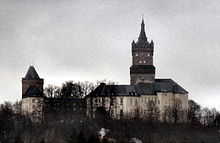Duchy of Cleves
This article needs additional citations for verification. (September 2023) |
51°47′N 6°8′E / 51.783°N 6.133°E
County (Duchy) of Cleves | |||||||||
|---|---|---|---|---|---|---|---|---|---|
| 1020 (traditional)–1795 | |||||||||
Banner of Cleves-Mark
(Beyeren Armorial) | |||||||||
Cleves | |||||||||
| Common languages | |||||||||
| Religion |
| ||||||||
| Government | Berg | 1521 | |||||||
• To Brandenburg | 1614 | ||||||||
| 1795 | |||||||||
• Province of Jülich-Cleves-Berg | 1815 | ||||||||
| |||||||||
The Duchy of Cleves (
Guelders and the Westphalian county of Mark
. The Duchy was archaically known as Cleveland in English.
The duchy's territory roughly covered the present-day
Cleves (northern part), Wesel and the city of Duisburg, as well as adjacent parts of the Limburg, North Brabant and Gelderland provinces in the Netherlands
.
History
In the early 11th century Emperor
Dietrich I was the first Count of Cleves and reigned from 1092 through 1119. In 1355 Zevenaar
passed from the control of the Duchy of Guelders to the Duchy of Cleves.
Upon the death of Count
.

The Cleves-Mark territories became one of the most significant estates of the
Henry VIII.[2]
Frederick William I of Brandenburg in 1666[4] and part of the Kingdom of Prussia after 1701, Cleves was occupied by French forces in the Seven Years' War
(1757–1762).
In the 1795
Napoleon, the duchy became part of the Prussian Province of Jülich-Cleves-Berg, which merged in the Prussian Rhine Province in 1822.[5] The cities Gennep, Zevenaar, and Huissen became part of the United Kingdom of the Netherlands as a result of the 1815 Congress of Vienna
.
Rulers of Cleves

Counts of Cleves

House of Cleves
The House of Cleves considers itself to be descended from Rutger von Antoing, a
enfeoffed of imperial property near Kleve in 1020, and Tomburg Castle some time after. The first documented lord from the House of Cleves is Dietrich, numbered variously as II or III, in 1092.[6]
- 1092–1117/8 Dietrich II or III[6]
- 1117–1134 Arnold I, his son. Either he or Arnold II married Ida, daughter of Count Gottfried von Löwen[6]
- 1134–1150 Arnold II[6]
- 1150–1172 Dietrich III [IV]. Married Aleidis von Sulzbach[6]
- 1172–1193 Dietrich IV [V]. Married Margarete von Holland[6]
- 1193–1202 Arnold III. Married Aleidis von Heinsberg[6]
- 1202–1260 Dietrich V [VI][6]
- 1260–1275 Dietrich VI [VII][6]
- 1275–1305 Dietrich VII [VIII][6]
- 1305–1310 Otto I the Peaceable[6]
- 1310–1347 Dietrich VIII [IX] the Pious[6]
- 1347–1368 Johann[6]
House of La Marck
- 1368–1394 Adolf III of the Marck
- 1394–1448 Adolph I, son of Adolf III
Dukes of Cleves
House of La Marck
- 1394–1448 Adolph I, Duke of Cleves
- 1448–1481 John I, son of Adolph I
- 1481–1521 John II the Pious, son of John I
- 1521–1539 John III the Peaceful, son of John II
- 1539–1592 William the Rich, son of John III
- 1592–1609 John William, son of William
Notable people
- Anne of Cleves, Henry VIII’s fourth wife, married in 1540
- Karl Harst, sixteenth-century diplomat[7]
References
- ^ Haude, Sigrun. In the Shadow of "Savage Wolves": Anabaptist Münster and the German Reformation During the 1530s. Brill (2000) p. 72
- ^ "Wilhelm II, Duke of Jülich-Cleves-Berg", The British Museum
- S2CID 144914347.
- ^ One or more of the preceding sentences incorporates text from a publication now in the public domain: Chisholm, Hugh, ed. (1911). "Frederick William of Brandenburg". Encyclopædia Britannica. Vol. 11 (11th ed.). Cambridge University Press. pp. 67–68.
- ^ Romeyk, Horst (1985). Verwaltungs- und Behördengeschichte der Rheinprovinz 1914–1945 [History of Administration and Public Authorities of the Rhine Province 1914–1945] (in German). Düsseldorf: Droste Verlag. pp. 123 ff.
- ^ a b c d e f g h i j k l m Biographie, Deutsche. "Kleve - Deutsche Biographie". www.deutsche-biographie.de (in German). Retrieved 2024-02-11.
- .
External links
Wikimedia Commons has media related to Duchy of Cleves.
- Edicts of Jülich, Cleves, Berg, Grand Duchy Berg, 1475–1815 (Coll. Scotti) online
- Settlement of Dortmund between Brandenburg and Palatinate-Neuburg and the conflict of succession in Jülich, in full text
- Map of the Duchy of Cleves in 1789



